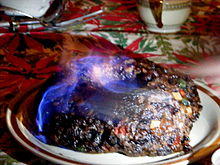Figgy Pudding (occasionally misnomered Piggy-Pudding) is a vague term used for a class of traditional seasonal winter dishes usually forming sweet & savory cakes, containing a sour-sweet creamy layer of honey, fruits and nuts. In later times, rum or other distilled alcohol became often added to enrich the fruitfullness of the flavor.
Etymology
Medieval cooking commonly employed figs, in both sweet and savoury dishes.[1] One such dish is fygey, in the 14th century cookbook The Forme of Cury, which in Modern English is "figgy", this dish being known as figgy pudding or fig pudding:[2][1][3]
The Middle English name had several spellings, including ffygey, fygeye, fygee, figge, and figee.[6][7][8] The latter is a 15th century conflation with a different dish.[7] Figee was in fact a dish of fish and curds, which was named figé in Old French, meaning "curdled" (the past participle of the Old French figer).[7][6][9] But it too came to mean a "figgy" dish, involving cooked figs, boiled in wine or otherwise.[7] A turn of the 15th century herbal has a recipe for figee:
Liber Cure Cocorum has the recipe under the name "fignade" on page 42.[6][8] Richard Warner's Antiquitates Culinariae has it under the name "fyge to potage".[6][12][8] Mrs Beeton's Book of Household Management contains two different recipes for fig pudding that use suet, numbers 1275 and 1276.[13]
Popular culture
Often associated with the original traditions of Christmas, it is most notably referred to in the Christmas carol "We Wish You a Merry Christmas" in the line "Now bring us some figgy pudding!".[14] Figgy pudding is not plum pudding, although it can be considered a precursor to it. It is not as rich, nor as complex in its recipe.[2] A number of Christmas markets will offer figgy pudding flavored desserts as part of their range, though the relation of these to the original taste-wise is rather doubtful.
References
Cross-reference
- ^ a b Threlfall-Holmes 2005, p. 61–62.
- ^ a b Breverton 2015, p. 236.
- ^ Hieatt, Nutter & Holloway 2006, p. 113.
- ^ Pegge 2014, p. 45.
- ^ Albala 2006, p. 65.
- ^ a b c d Austin 1888, p. 129.
- ^ a b c d Shipley 1955, p. 267.
- ^ a b c Hieatt, Nutter & Holloway 2006, p. 38.
- ^ Morton 2004, p. 51.
- ^ Austin 1888, p. 113.
- ^ Ayto 2012, p. 133.
- ^ Warner 1791, p. 67.
- ^ Beeton 2006, p. 618.
- ^ Cassidy 2004, p. 48.
Reference bibliography
- Albala, Ken (2006). "The Middle Ages 1300–1450". Cooking in Europe, 1250–1650. Daily life through history. Greenwood Publishing Group. ISBN 9780313330964. ISSN 1080-4749.
- Ayto, John (2012). "figee". The Diner's Dictionary: Word Origins of Food and Drink. Oxford University Press. ISBN 9780199640249.
- Austin, Thomas (1888). Two Fifteenth-Century Cookery-Books. N. Trübner & Co. (Two Fifteenth-Century Cookery-Books at the Internet Archive)
- Beeton, Isabella (2006). Mrs Beeton's Household Management. Wordsworth Editions. ISBN 9781840222685.
- Breverton, Terry (2015). "Sweets". The Tudor Kitchen: What the Tudors Ate & Drank. Amberley Publishing Limited. ISBN 9781445648750.
- Cassidy, Jennie (December 2004). "Now bring us some figgy pudding!". Early Music Review. King's Music. 104. ISBN 9783761815946.
- Hieatt, Constance Bartlett; Nutter, Terry; Holloway, Johnna H. (2006). Concordance of English Recipes: Thirteenth Through Fifteenth Centuries. Medieval & Renaissance Texts Studies. 312. ACMRS. ISBN 9780866983570.
- Morton, Mark (2004). "bouce Jane". Cupboard Love 2: A Dictionary of Culinary Curiosities. Insomniac Press. ISBN 9781897415931.
- Pegge, Samuel, ed. (2014). The Forme of Cury, a Roll of Ancient English Cookery. Cambridge University Press. ISBN 9781108076203.
- Shipley, Joseph T. (1955). "figee". Dictionary of Early English. Rowman & Littlefield. ISBN 9781442233997.
- Threlfall-Holmes, Miranda (2005). Monks and Markets: Durham Cathedral Priory 1460–1520. Oxford University Press. ISBN 9780199253814.
- Warner, Richard (1791). Antiquitates Culinariae, Or Curious Tracts Relating to the Culinary Affairs Of The Old English. London: R. Blamire.
